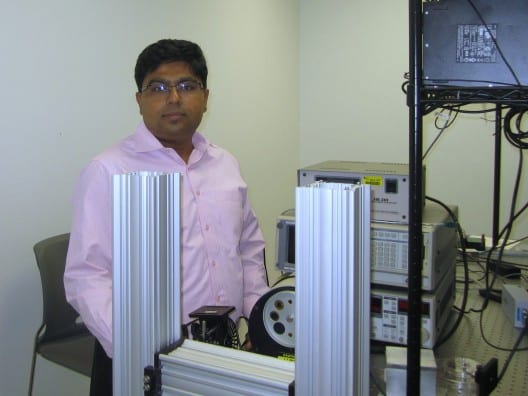Physics Student Wins International Prize
Story by Zenaida Gonzalez Kotala, UCF Today

Physics doctoral candidate Daniel Franklin
One of the world’s leaders in liquid-display technology has selected a UCF project led by professor Debashis Chanda, Ph.D., and physics graduate student Daniel Franklin for its “2016 Displaying Futures Award.”
The Germany-based company Merck selected UCF’s plasmatic full-color display project as its top pick from 30 others in an exclusive invitation-only competition.
Ten international finalist teams pitched their ideas and showcased their prototypes to Merck leaders. Then they answered detailed questions before a panel of judges and live audience during the final evaluation.
According to Merck, the goal of the new award is to identify new display applications and support further development of the materials.
As part of the prize, UCF’s team will receive mentoring from experts within and outside of Merck KGaA, Darmstadt, Germany, access to a global network, and financial support.

Nanoscience and CREOL researcher and professor Debashis Chanda, Ph.D.
Teams from Kent State University and the Eindhoven University of Technology in the Netherlands were also named winners.
Chanda, a nanoscience and CREOL researcher and professor, and Franklin, a physics doctoral candidate, along with Silicon Valley investor Negendra Nagarajayya agreed to enter the team’s work in the competition because Merck is an industry leader, Chanda said.
The team developed a breakthrough technology last year that produced the full-color, flexible think-film reflective display. The team’s work was published in the Nature Communications journal. Since then the team has enhanced its technology. Franklin has been engineering the electronic modifications necessary to integrate the film into current technology, while the team continues to look for futuristic applications.
“This display will change the world market,” said Sudipta Seal, director of UCF’s NanoScience Technology Center. “This is the kind of impactful research we strive for here.”
For example, there is the promise that the film could be used to turn bulky virtual reality helmets used for gaming and simulated military training, into a simple pair of sunglasses. The glasses would provide the high resolution needed for a complete virtual world.
The film could be used with pico-projectors that could shoot high- resolution, life-like images used as roadside billboards with video- playing ability. Another option: a wearable cloth-mounted display for maps and health-information monitoring.
“These applications are still a few years away,” Franklin said. “But they are within the realm of possibility. So much is happening in optics and nanotech right now, it’s exciting.”
The award comes with $50,000 seed money, Chanda said
“A lot of other teams had working prototypes that were really sharp,” Chanda said. “We couldn’t build a prototype in the absence of funding. We need venture capitalists for that, so I focused on the sound science. We’ve proven it can work and Merck agreed. Now we hope more investors step forward to bring this to market.”
